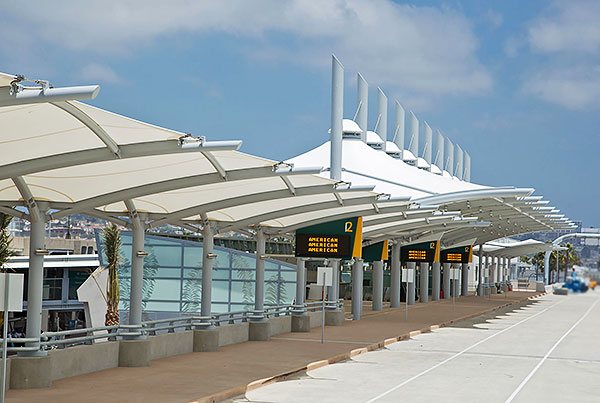 There are many types of architectural fabrics in common use today, but only a select few of them are applied to the kind of tensile membrane construction that a very elite and small number of specialty contractors today do. This post won’t really put one architectural fabric against another, but it will tell you about the types available today. They include:
There are many types of architectural fabrics in common use today, but only a select few of them are applied to the kind of tensile membrane construction that a very elite and small number of specialty contractors today do. This post won’t really put one architectural fabric against another, but it will tell you about the types available today. They include:
- PTFE
- Silicone-coated fiberglass
- Woven PTFE
- PVC-coated polyester
- PVC-laminated polyester
- High-density polyethylene (HDPE)
- ETFE
Without trying to reinvent the wheel, the best way to determine which material to use is to see what has already been used for the building type you are considering.
If you are interested in structures such as tents or umbrellas where the main objective is to provide temporary, nomadic shelter, you are probably looking at vinyl laminated or coated polyester.
If you are researching awnings and canopies, the options are endless. You are most likely to hear words like acrylic canvas and backlit fabrics and materials which you can also apply graphics too.
If shade is your primary concern, the buzz word is structural mesh, high-density polyethylene (HDPE), perforations and % of light transmission.
For warehousing, industrial applications and temporary buildings, a common term may be clear spans or pre-engineered fabric buildings with materials that are mold and mildew resistant. Our partner company, Guard-All, specializes in these type of structures and can give you a quote, right over the phone.
Air and tension fabric structures rely heavily on its fabric’s structural characteristics and tensile strength, sound absorption and solar transmission play a major role in their selection. The photo accompanying this post is of the new San Diego International Airport “Smart Curb” canopies, designed and built by FabriTec Structures. In total, the new Smart Curbs include: 18 Pavilion canopies, 28 Elevated Department Roadway (EDR) canopies, 35 ground structure canopies, and 2 long-term parking canopies – all of which cover more than 70,000 square feet of surface area using PTFE Sheerfill II and V architectural fabric.
Your PFEIFER Structures’ designer or sales associate can help steer you towards the material that is right for your project, or you can take our AIA Continuing Education course, Anatomy of a Tension Structure, and in it learn more about how to choose the right kind of material for your fabric architecture project. This course earns architects 1 HSW credit and gives you a step-by-step procedural overview of the tensile membrane design process, from conceptualization to completion.





